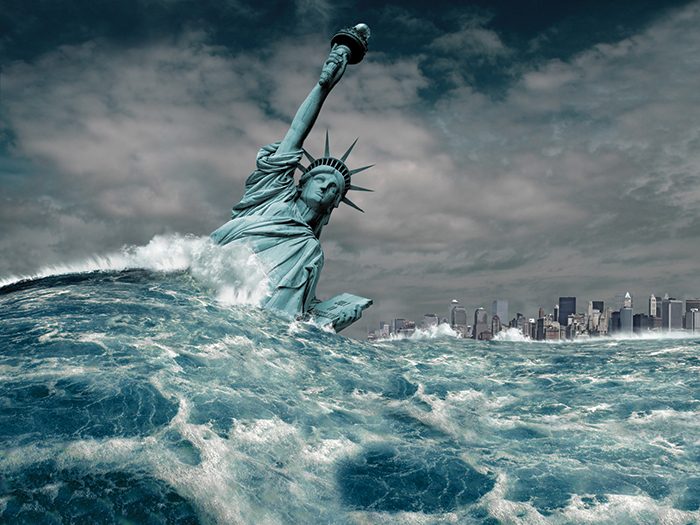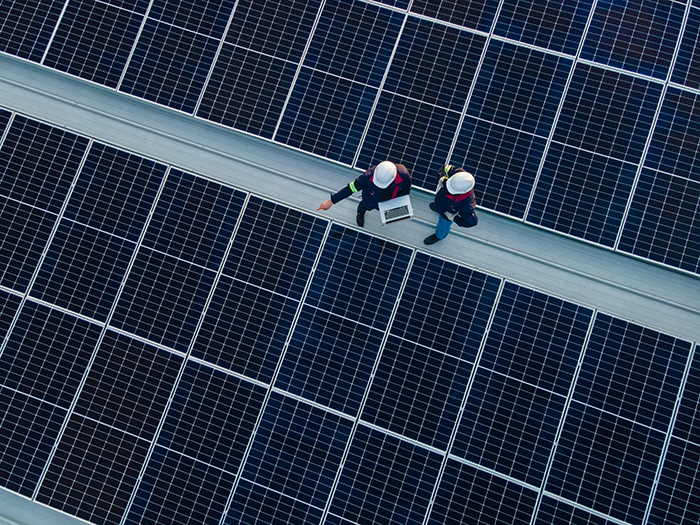Black Swan: Mega-Tsunami
A Mega-Tsunami Is Coming; Can the East Coast Even Prepare?

Scenario: La Palma earned the nickname “the beautiful island” — white sand beaches highlighted by black volcanic soil. An endless night sky filled with stars as far as the eye can see.
But beauty here is only skin deep.
Nestled on the western side of La Palma sits the Cumbre Vieja volcano, like a pot of water waiting to boil over. Its last big eruption was more than 50 years ago, but everyone knows it’s only a matter of time before it unleashes the beast inside.
It starts with tremors. Glasses rattle on kitchen tables while picture frames skew left and right. Tourists to La Palma brush it off, calling the jelly feeling “sea legs” — they are, after all, on an island.
But the locals know better and they hold their breath. When it does happen, the ash and lava spill out of the volcano’s mouth like a giant sigh. No one could have predicted what happens next.
The western side of the volcano cracks and splits; the steam builds up inside and pushes against the volcano’s walls. The pressure is too much; the entire western flank breaks off, the Atlantic Ocean eagerly swallowing every rock, stone and pebble as they freefall into its deep blue depths. The earth rumbles and the water begins to slosh around as its calm ebb and flow turns into frenzied splashing and crashing.
The waves grow. And they grow and they grow. To the naked eye, it looks like the heavens unleashed a curtain made of water — somehow the volcano’s landslide has produced a tsunami that reaches the sky.

And this mega-tsunami moves fast.
All 3,000 feet of water roars as it barrels away from La Palma’s coast toward the United States. As the most western island of the Canary Islands, La Palma sits eight to 10 hours away from the eastern shore by plane. It’s the one piece of good news: Residents have a window of time to evacuate.
But chaos breeds chaos, and soon the highways are clogged with cars, frightened families from Boston to Miami trying to flee inland. A final silver lining: The wave decreases as it sojourns across the Atlantic from a staggering 3,000 to a mere 160 feet.
The wave touches down, flowing onto beaches and flooding bays. Coastal buildings don’t stand a chance; water rushes inland 10 miles along the entire eastern seaboard. Homes are destroyed, countless hotels crumble under the force. Chemical plants that once churned out product by the oceanside spill their toxic waste into the sea.
Beaches up and down the coast account for billions of dollars in tourism revenue each summer. It looks like vacationers might not be able to return for decades thanks to the amount of oils and solvents released.
On top of that, the East Coast is home to 29 percent of the U.S. population. Now they are displaced — their homes destroyed, their cities flooded. Not everyone made it out in time.
It’s not the end of the world, but it very much feels like it.
Analysis: La Palma’s mega-tsunami is a disaster, no doubt. And — scarily enough — it’s not impossible.
In 1949, the Cumbre Vieja volcano erupted along the coast of La Palma and caused an earthquake that created a mile-long fissure on its east side.
The force of the fissure then caused the volcano’s west side to slip six feet into the Atlantic Ocean. It has since remained in this position, its estimated 1.5 trillion metric tons waiting like a ticking time bomb.
Researcher and scientist Steven Ward, now a research geophysicist at the Institute of Geophysics and Planetary Physics, UC Santa Cruz, and Simon Day, a senior research associate at the Institute for Risk & Disaster Reduction, University College London, first quantified the features of the La Palma mega-tsunami.
They looked at the geological structure of the volcano and created simulations of the event, which can be seen on Ward’s YouTube channel.
If circumstances align and the volcano erupts powerfully enough, the western half of the volcano could fall into the ocean and create this mega-tsunami scenario in full, the research concluded.
“La Palma is a volcanic island,” said Ward. “It’s built up from ash and lava that pushed out layers like a stack of shingles on a sloping roof. Sometimes, volcano sides become unstable and like that stack of shingles, part of the pile slides off. It’s a common thing [to have] huge pieces of debris fall off.”
“The unusual structural evolution of the volcano, revealed by changes in the distribution of eruption sites over its surface since about 10,000 years ago, could best be explained by the progressive development of a landslide surface under that western flank and consequent weakening,” added Day.
“Satellite radar data has shown that a large section of the west flank is continuing to move very slowly … despite the fact that it is not being pushed by magma rising to the surface within the volcano,” he said.
“La Palma has a lot of water in it,” Ward explained. “The thinking is that in some future eruption, hot magma will reach this water, turn it into steam and the steam will split the mountain.”
A landslide of this scale could send out a mega-tsunami-sized wave. Ward said the hard part is predicting if, or when, the landmass will actually slide into the Atlantic.
Such an event won’t likely come out of the blue, he said. There will be a buildup of volcanic and tectonic activity beforehand that will aid researchers in forecasting a potential disaster.
In fact, earlier this year, residents of the island feared the worst as La Palma encountered more than 40 mini-earthquakes within a 48-hour period. Large tremors stemming from Cumbre Vieja followed soon after, though the volcano never erupted.
A Catastrophe Too Big to Predict
A mega-tsunami is hard to predict and prepare for. On a smaller scale, tsunamis themselves are rare enough events.
“Usually you have significant property and clean-up — and BI damage or costs,” said Ed Mazman, president of property, Ironshore.
Specifically, Mazman said, coastal businesses are most at risk: “A lot of that is hospitality, hotels, resorts. This is a tremendous event, uncontrollable exposures.”
There are ways to prepare for a “typical” tsunami, but when it comes to an event like this and the size of the potential wave, “I don’t think we could really protect against it,” he said.
“It’s like a tornado. You could have a structure prepped for a tornado, but if it’s in the way of a CAT 5, that tornado’s going to win.” — Ed Mazman, president of property, Ironshore
“Firms are thinking about life safety over property damage. You can’t really protect property. If it’s in the path, if it’s close enough — it’s like a tornado. You could have a structure prepped for a tornado, but if it’s in the way of a CAT 5, that tornado’s going to win,” Mazman said.
The best example to look at in terms of damage done is Superstorm Sandy, which hit the East Coast in October 2012.
While Sandy gives an idea of the extent of damage to expect, a mega-tsunami still differs in one glaring way: the area impacted. This is not just one city bearing the brunt of the damage; anything in between Boston and Miami could feel the wrath of the tsunami.
“Every scenario [already modeled] seems to be limited to one geographic area, like a large metropolitan area. If a CAT 5 hurricane were to hit Miami, it’s $150 to $200 billion. This [mega-tsunami] would be at least 10 times that,” said Mazman.
The good news: There’s a window of time for those on the East Coast to evacuate before a mega-tsunami even touches down on land.
“A tsunami travels as fast as a jet airplane, 400 to 500 miles per hour. But the ocean’s pretty big. From La Palma to the East Coast, it would take eight to 10 hours for a mega-tsunami to get there,” Ward explained.
Mazman said that because of this extra time and the fact that the United States is a tech-savvy country, the coast might see a lower loss of life than anticipated from an event like this.
To put it into perspective, in late 2004, a tsunami hit Indonesia after the third-largest recorded earthquake rumbled its way through the Indian Ocean. Nearly 280,000 people were killed by waves measuring as high as 100 feet.
The residents only had 20 minutes between the earthquake and the tsunami hitting land to evacuate — not nearly enough time to even register a tsunami was on its way.
With La Palma’s mega-tsunami, however, Ward said there would be enough activity months in advance, leading up to that final landslide.
Measuring the Environmental Impact of a Mega-Tsunami
With East Coasters safely out of the way, it’s the clean-up that will take the longest.
Petroleum-based fuels and solvents will leave a lasting impact on the environment long after flood waters recede.
After Hurricane Harvey, the CAT 4 hurricane that hit Houston in 2017, several oil and chemical refineries were hit with huge penalties for environmental violations. House and shared water wells had to be cleared of growing bacteria. The air quality took a significant hit as well.
On top of pollutant issues, because of the size and scale of a mega-tsunami, many sea creatures might be displaced or run aground, disrupting deep-water ecosystems.
The scariest factor is the number of nuclear power plants concentrated on the East Coast. In 2011, a 50-foot tsunami hit Japan, disabling the power supply and cooling system for three nuclear reactors in Fukushima, causing them to melt down. Former residents are still waiting to return to the area.
With the potential for nearly 40 East Coast plants to melt down, some areas in the U.S. may never be inhabitable again.
Preparing for the Worst
Though La Palma’s mega-tsunami would be hard to predict and even harder to mitigate the risk, coastal properties can start by investing in flood and storm surge insurance, stabilizing structures with wind and water resilient materials, or adding in water sensors.
Clients would have insurance and be prepared for flood, Mazman said, “but this would have a huge financial impact beyond the insurance industry. It would be interesting to see the view from CAT modeling firms on an event of this magnitude.
“I can’t imagine a loss of that scale. It would be a world-wide disaster. Insurance would not be able to cover enough.”
However, Mazman said: “The one way to prepare would be to add in a warning system. The Pacific and Indian Oceans have one. Does the Atlantic?” &












